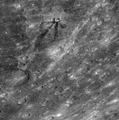Fitxer:Matabei crater EN0131773885M.png
Aparença

Mida d'aquesta previsualització: 596 × 600 píxels. Altres resolucions: 239 × 240 píxels | 477 × 480 píxels | 1.018 × 1.024 píxels.
Fitxer original (1.018 × 1.024 píxels, mida del fitxer: 1,11 Mo, tipus MIME: image/png)
Historial del fitxer
Cliqueu una data/hora per veure el fitxer tal com era aleshores.
| Data/hora | Miniatura | Dimensions | Usuari/a | Comentari | |
|---|---|---|---|---|---|
| actual | 01:00, 3 maig 2010 |  | 1.018 × 1.024 (1,11 Mo) | Bryan Derksen | {{Information |Description={{en|1=Image Mission Elapsed Time (MET): 131773885 Instrument: Narrow Angle Camera (NAC) of the Mercury Dual Imaging System (MDIS) Resolution: 520 meters/pixel (0.32 miles/pixel) at the top of the image Scale: The top of this im |
Ús del fitxer
La pàgina següent utilitza aquest fitxer:
Ús global del fitxer
Utilització d'aquest fitxer en altres wikis:
- Utilització a en.wikipedia.org
- Utilització a it.wikipedia.org
- Utilització a ja.wikipedia.org
- Utilització a www.wikidata.org



